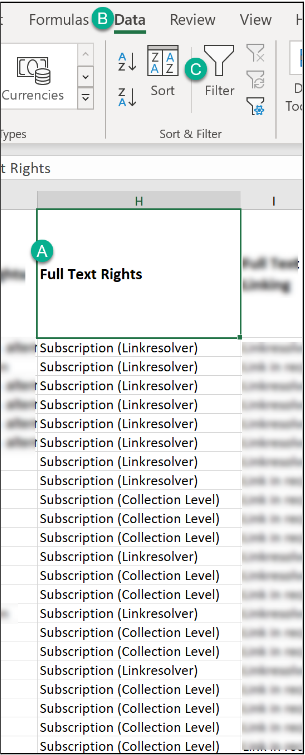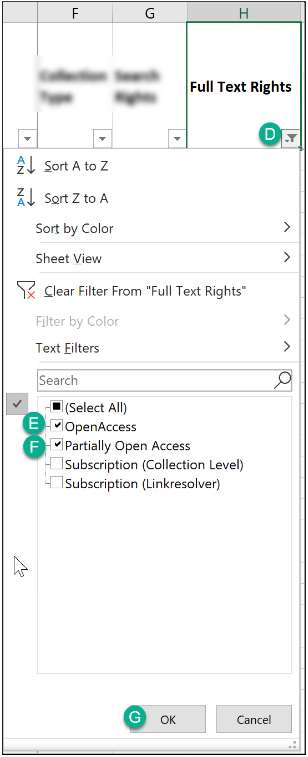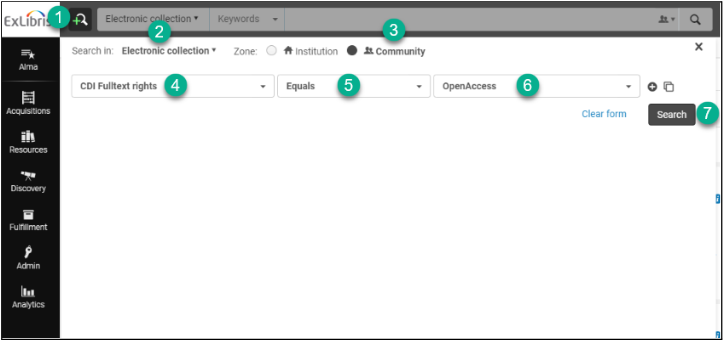Open Access Collections in the Ex Libris Central Discovery Index
By Mary McMillan, El Camino College and Sean A. Flores, San Diego Mesa College
Introduction
This past year, discussions on the integration of library database content with the new California Community College (CCC) statewide library services platform (LSP), Ex Libris Alma, began to take shape. Libraries gained experience making content discoverable in their live instances of Ex Libris Primo VE post-migration, while raising more questions about the many “open access” (OA) collections available for activation in Alma. Examples include collections of freely accessible journals (e.g. DOAJ), popular open educational resources (OER) such as the textbooks offered by OpenStax, and a wide variety of in-between content. Librarians are looking for for guidance on the potential benefits and drawbacks with bringing open access content into Primo VE results, as well as how to locate and activate these collections in Alma, how to determine a collection’s scope, and how to select open access collections that have the most potential for supporting the information needs of our community college libraries.
Members of the Electronic Access & Resources Committee of the Council of Chief Librarians, California Community Colleges (CCL-EAR) discussed whether or not it would be within the Committee’s purview to review open-access collections available for activation in Alma and, if so, from what lens. We know that similar discussions on open access integrations are taking place within the LSP workgroups so we did not want to risk duplicating their work on this subject, and we also deliberated over whether or not these fell outside those library e-resources that are traditionally reviewed by the Committee and offered through the California Community College Library Consortium (CCLC). However, as CCL-EAR “is charged to explore ways in which the resources of the community college libraries could be maximized through cooperative ventures for electronic resources, databases, and information,” the Committee determined there is a place for contributions to the discussion, and we undertook this examination.
In the February 2021 CCL Outlook, Ryan Edwards of West Los Angeles College shared his insightful article “Making OER Discoverable in OneSearch,” where he described his strategy of using Primo’s Resource Recommender service to increase visibility of available Open Educational Resources to his campus. This article is an effort to build upon Ryan’s suggestions with further insights into available open access collections, recommendations for librarians to consider prior to such activations with instruction on locating them, and offer a spreadsheet of data on open access resource collections available for activitation from the Central Discovery Index (CDI) that could be useful in collection evaluation.
Librarian Interest
Librarians play a role in supporting scholarly open access and linking students to freely available online collections and, in more recent years, have taken leadership roles to push forward campus OER and affordable learning initiatives. However, the discovery of these resources can be challenging for students and faculty alike. The inclusion of packaged open access collections in Ex Libris’ Central Discovery Index (CDI) allows the opportunity to make these materials discoverable in Primo VE alongside database subscription content, thus expanding library collections. While some subscription packages do contain open access within them (e.g. EBSCO Academic Search Complete), as defined by Ex Libris, these are not the focus of this article.
Open Access Content in the CDI
According to the Ex Libris Knowledge Center, content in the Central Discovery Index is considered open access if it meets the following general criteria:
- An item is freely available and openly accessible without requiring authentication by the user.
- An item is identified by the provider/publisher as open access.
- An item resides in a known open access repository, database, or journal collection that Ex Libris determines to be open access.
In the Central Discovery Index, content can be identified as open access at the collection level for open access repositories and open websites. There is not a consistent way to identify open access content across different providers and content types. As such, metadata for all collections from participating providers must be carefully analyzed to determine the best methods for identifying whether the content is open access or not. In many cases, Ex Libris must apply conditional rules and logic to the metadata at indexing time to correctly identify and differentiate open access content from subscribed content.
In the case of collections with hybrid content (collections of primary publishers where some articles from a journal are open access and others are not), for example, Ex Libris has started to separate the collection into two collections: one collection for subscribed content and the other for open access content, regardless of whether the open access content is coming from full open access journals or hybrid journals. Over time, you can see an increasing number of these collections appearing in the Central Discovery Index.
Considerations Prior to Activation
With the administration of shared CCLC database collection in the Network Zone (NZ) now underway, there have been suggestions to add a select number of open access collections with potential interest to CCC libraries to the Network Zone. If added to the NZ, individual libraries would still have the option not to activate them locally. This process would also help the LSP stay under the contractual bibliographic record limit. As with any kind of collection development, librarians should be selective regarding open access activations to ensure the best possible discovery experience in Primo VE for their user communities. It is recommended that the following be considered before activating an open access collection in Alma:
- Content Scope: It is important to review the collection to determine the scope of the included content. Open access collections may include open scholarly journals and eBooks (e.g., JSTOR Open Access eBooks), digital content shared from an institutional repository or archive (e.g., Vanderbilt University), or even articles from public websites (e.g., Wikipedia). They can be multidisciplinary in scope or have a narrowed subject focus supporting only specific academic programs, and they can also contain publications in many different languages.
- Full or Partial Access: While many of the open access collections available for activation in Alma freely link to the full-text of the offered collection in its entirety, there are collections where only some of the content is open access. Whether or not to activate collections where full-text access is unavailable should be made at the individual library level.
- Content Overload: Collection size should be a consideration as some open access collections are so large (e.g. HathiTrust and Project Gutenburg) that they have the potential to bury local and subscribed content in Primo VE results. In addition, the threshold for bibliographic records, based on the system contract with ExLibris, is an important factor for both local activations and those which may be done system-wide via the Network Zone.
- Collections vs. Portfolios: Libraries may decide whether to activate an entire open access collection or, depending on their overall collection development parameters and user needs, a select number of available portfolios. For example, rather than activate an entire collection of open access eBooks a library may prefer to make available only those titles within a set date range, or covering a particular subject area of interest to local researchers.
- Open Educational Resources: As campus OER and Zero Textbook Cost (ZTC) degree initiatives develop, some libraries may consider the potential benefits of including OER textbooks in their discovery catalog, either as entire collections or by activating individual portfolios that are used on their campuses. As noted, The Ex Libris CDI currently includes collections from some of the larger OER publishers/repositories (e.g., OpenStax) and there has been a push for the expansion of available collections to include PressBooks and LibreText content. Doing so could aid student access to OER being used in their courses via Primo VE, providing another place for faculty to search for OER available in their discipline. However, it is important to note that OER textbooks activated in Alma include the portfolio of the original editions made available within that particular collection and do not reflect any remixing, or customizations, that may have been done by individual faculty or other “downstream” users.
Finding OA collections in The CDI
Ex Libris provides two methods of identifying and activating open access collections.
Method 1: CDI Collection List
- Locate and open the CDI Collection List.
- The Ex Libris Knowledge Center provides a CDI Collection List that is updated every month.
- Navigation to the CDI Collection List can also be found through the following path upon visiting the ExLibris Knowledge Center website: Knowledge Center Home Page >> Alma >> Product Documentation >> Alma Online Help (English) >> Electronic Resource Management >> CDI Collection Lists for Alma Customers
- To only view collections with OA content in the CDI Collection List, filter the Full Text Rights field to Open Access or Partially Open Access.

Method 1 - Excel Filter Selection

Method 1 - Excel Filter Criteria
- Select the Full Text Rights header field
- Select the Data menu tab
- Select the Filter Icon

- Select the Small Filter Icon that now appears on the Full Text Rights header field.
- Select OpenAccess
- Select Partially Open Access
- Confirm selections using the OK button.
Method 2: Export an Advanced Search in Alma
A report can also be run manually in Alma and exported into Excel:


- Log into Alma and select the Advanced Search icon

- Set Search in field to Electronic collection
- Select the Zone field’s radio button to Community
- In the first advanced search field select CDI Fulltext rights
- In the second advanced search field select Equals
- In the third advanced search field select OpenAccess
- Select Search button
- On the results screen, select the Export List icon
- Select Excel.
You will now have the latest OA Collections information in an Excel spreadsheet to help with your evaluations for activations/deactivations.
Evaluating Open Access Collections in CDI
The MnPALS Consortium, a group of 54 academic and state government libraries in Minnesota, migrated to Alma and Primo VE several years ago, going live in January 2019. As part of their work to craft consortium-wide recommendations for Primo Central Index (PCI) collection activations, including open access resources, the MnPALS ERM workgroup put together a spreadsheet that helped clarify the scope of available open access collections at that time. They also provided recommendations for which collections to activate in a webinar at UNYLA.
The MnPALS ERM group decided to be conservative with their list of recommendations and suggested that all collections classified by Ex Libris as partial open access be de-selected or non-activated. However, they suggested that local institutions may still wish to activate some of these collections, particularly if the local institution has a subscription to the content with a corresponding selective-title package in Alma. They classified resources into three categories based on recommended activation action: Yes, No, and Optional. “Optional” collections were generally ones that were subject-specific (e.g., physics) or content-specific (e.g., Government documents). The group reasoned that certain institutions with programs or special collections in these areas might be interested in “opting-in”/activating these collections. The relatively few “Yes” collections in their list are open access collections from larger, well-known publishers, are highly multidisciplinary in subject in content, or are open access textbook collections.
The MnPALs metadata from their recommended open access collections spreadsheet was based on the PCI, but the collection names have since changed when Ex Libris moved to the CDI in 2020. Therefore, the information needed to be mapped to the eCollection names that are used in CDI in order to better utilize the open access work done by MnPALs. Further, the MnPALS spreadsheet contained useful metadata that we wanted to map over to the appropriate CDI collections.
The Ex Libris Knowledge Center provides two documents that allow us to map the PCI-based collections in the MnPALS spreadsheet to their CDI collections: the CDI Collection List, and the PCI to Alma Mapping Table. The CDI Collection List and the PCI to Alma Mapping Table were both used to identify PCI collection names from the MnPALS spreadsheet with their corresponding collection in CDI. The MnPALS spreadsheet fields for ACTIVATE, DESCRIPTION/SUBJECT, and REASON FOR DESELECTION/NON-ACTIVATION were also mapped to a May 2021 version of the CDI Collection List.
The information is now mapped, but it should be noted that the CDI open access collections are continuously evolving. Collections that were “Partially Open Access” (collections that had a combination of subscription and open access content) are having their open access content pulled into their own CDI open access collections for easier overall activation of open access content. It should also be noted again that Ex Libris updates the CDI Collection List monthly. The information shared in the newly created spreadsheet is based on the May 2021 CDI list.
Information that could be useful for the evaluation of open access collections from the original MnPALS spreadsheet are now reflected on a new mapped collection list, CDI OpenAccess Recommendations (May 2021).1

When reviewing the CDI OpenAccess spreadsheet, there are two main areas. One area marked with blue column headers indicates the data columns from Ex Libris’ CDI Collections List as of May 2021. The yellow column headers are the mapped data from the MnPALS spreadsheet. The combined view will allow you to utilize the analysis done by the MnPALS group and associate them with the applicable CDI collection in Alma to assist with your own evaluations of open access collections for potential activation for your institutions.
Conclusion
Open access materials are varied and come in different combinations of material type and subjects. They are also placed into completely open or hybrid collections. Ex Libris is making an effort to separate the hybrid collections so that open access materials can be activated with less confusion, but this will be an ongoing effort on their end with more collections becoming available over time. While there are certainly many open access collections available in the CDI, individual libraries will need to determine which they may want to activate (if any) locally. The newly mapped open access spreadsheet can serve as a starting place for our collective consideration.
References
1. McMillan, Mary, and Flores, Sean A. on behalf of CCL-EAR Committee. “CDI OpenAccess Recommendations (May 2021).”↩